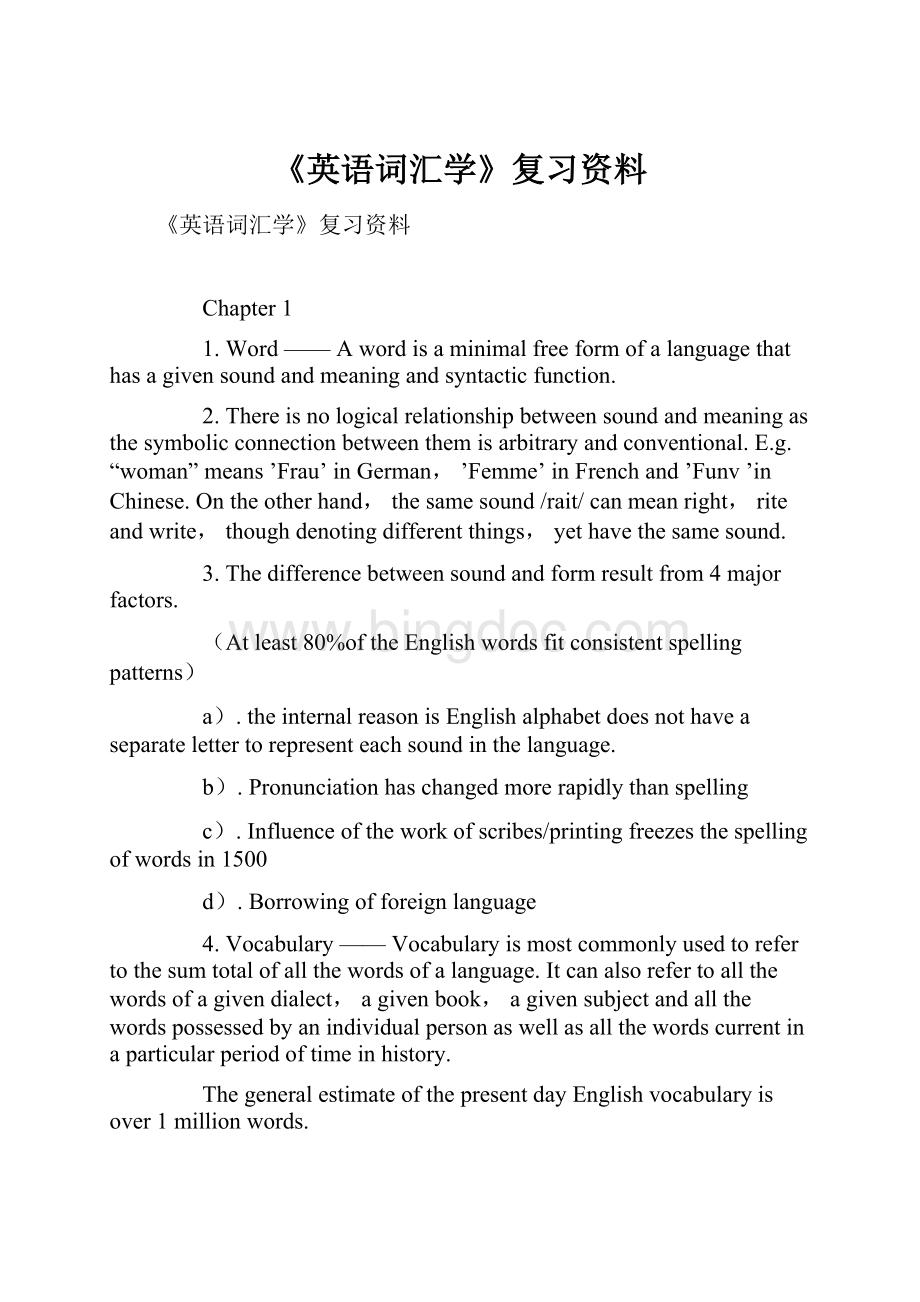《英语词汇学》复习资料Word文档格式.docx
《《英语词汇学》复习资料Word文档格式.docx》由会员分享,可在线阅读,更多相关《《英语词汇学》复习资料Word文档格式.docx(47页珍藏版)》请在冰点文库上搜索。

ThegeneralestimateofthepresentdayEnglishvocabularyisover1millionwords.
5.ClassificationofWords—byusefrequency,bynotion,byorigin
1).Basicwordstock–thefoundationofthevocabulary.
1.allnationalcharacter(mostimportant)–naturalphenomena
mostcommonthingsandphenomenaofthehumanbodyandrelations
worldaroundusnamesofplantsandanimals
action,size,domain,state
numerals,pronouns,prep.,conj.
2.stability–theydonatethecommonestthingnecessarytolife,theyareliketoremainunchanged.Onlyrelative,someareundergoingsomechanges.Butthechangeisslow.
e.g.arrow,bow,chariot,knight–pastelectricity,machine,car,plane——now
3.productivity–theyaremostlyrootwordsormonosyllabicwords,theycanformnewwordswithotherrootsandaffixes.e.g.foot–football,footage,footpath,footer
4.polysemy–oftenpossessmorethanonemeaning.Becomepolysemous.
e.g.taketomoveorcarryfromoneplacetoanother
toremove
5.collocability–quiteanumberofsetexpressions,idiomaticusages,proverbialsayingandothers
e.g.heart–achangeofheart,aheartofgold
Non-basicvocabulary——
1.terminology–technicalterms
photoscanning,hepatitis,indigestion,penicillin,algebra,trigonometry,calculus
2.jargon–specializedvocabularyincertainprofessions.
Bottomline,ballparkfigures,bargainingchips,holdhimback,holdhimin,paranoid
3.slang——substandardwordsoftenusedininformaloccasions
doughandbread,grassandpot,beaver,smoky,bear,catch,holler,Roger,X-rays,
Certainwordsarelabeledslangbecauseoftheirusage.
4.argot–wordsusedbysub-culturedgroups
can-opener,dip,persuader
cant,jargon,argotareassociatedwith,ormostavailableto,specificgroupsofthepopulation.
5.dialectalwords–onlybyspeakersofthedialect
beauty,chook,cocky,station,auld,build,coo,hame,lough,bog
6.archaisms–wordsnolongerincommonuseorrestrictedinuse.Inolderpoems,legaldocumentandreligiouswritingorspeech.
7.neologism–newlycreatedwordswithnewmeaninge.g.microelectronics,futurology,AIDS,internet,E-mail
oldmeaningacquirednewmeaninge.g.mouse,monitor
2).Contentword(notionalword)–denoteclearnotions.
Functionalword(emptyword,formword)–donothavenotionsoftheirown,expresstherelationbetweennotions,wordsandsentences.
a.ContentwordsconstitutethemainbodyoftheEnglishvocabularyarenumerous.
Functionalwordsareinasmallnumber.
b.Contentwordsaregrowing.
Functionalwordsremainstable.
c.Functionalwordsdofarmoreworkofexpressionthancontentwords.
3).Nativewords–arewordsbroughttoBritaininthe15centurybytheGermantribes.Ango-SaxonWords,50000-60000
Whatistrueofthebasicwordstockisalsotrueofnativeworld.Moreare
1.neutralinstyle(notstylisticalspecific)
2.frequentinuse(inacademicfieldsandscienceFrench,LatinorGreekareused)(usage70-90%)
Borrowedwords(loanwords,borrowing)–wordstakenoverfromforeignlanguage.80%
Accordingtothedegreeofassimilationandmannerofborrowing,wecanbringtheloanwordsunder4classes.
1.Denizens–wordsborrowedearlyandnowarewellassimilatedintoEnglishlanguage.
e.g.portfromportus(L)shift,change,shirt,porkcupfromcuppa(L)
2.Aliens–retainedtheiroriginalpronunciationandspelling
e.g.dé
cor(F)blitzkreeg(G)emir,intermez,rowtow,bazaar,rajar,statusquo
3.translationloans–formedfromtheexistingmaterialintheEnglishlanguagebutmodeledonthepatternstakenfromanotherlanguage.
1).Wordtranslatedaccordingtothemeaning
e.g.mothertoughfromlinguamaternal(L)
blackhumorfromhumornoir
longtimenosee,surplusvalue,masterpiece
2).Wordstranslatedaccordingtothesound
e.g.kulakfromkyrak(Russ) lamafromlama(Tib) ketchup tea
4.Semanticloans–theirmeaningareborrowedfromanotherlanguage
e.g.stupidolddump newsassy dreamoldjoyandpeace
pioneeroldexplorer/persondoingpioneeringwork newamemberoftheyoungpioneer
fresholdimpertinent,sassy,cheeky
Chapter2
Indo-Europeanlanguagefamily(Europe,theNearEast,India)
Balto–SlavicIndo-IranianItalicGermanic
PrussianPersianPortugueseNorwegian
LithuanianHindiSpanishIcelandie
PolishItalianDanish
BulgarianRoumanianSwedish
SlovenianFrenchEnglish
RussianGerman
AlbanianArmenianCelticHellenic
IrishGreek
Breton
Scottish
2.History(时间,历史事件,特征)
1)OldEnglish(450-1150)totally50,000-60,000words
The1stpeopleknowntoinhabitEnglandwereCelts,thelanguagewasCeltic.
ThesecondlanguagewastheLatinoftheRomanLegions.
TheGermanictribescalledangles,SaxonsandJutesandtheirlanguage,Anglo-SaxondominatedandblottedouttheCeltic.NowpeoplerefertoAnglo-SaxonasoldEnglish.
Attheendof6thcentury,theintroductionofChristianityhasagreatimpactontheEnglishvocabulary.
Thecommonpracticewastocreatenewwordsbycombiningtwonativewords.
Inthe9thcentury,manyScandinavianwordscameintoEnglish.Atleast900wordsofScandinavianareinmodernEnglish,ourdailylifeandspeech.
特点:
highlyinflectedlanguage
complexendingsorvowelchanges(fullending)
2)MiddleEnglish(1150-1500)English,Latin,French
Until1066,althoughtherewereborrowingsfromLatin,theinfluenceonEnglishwasmainlyGermanic.ButtheNormanConqueststartedacontinualflowofFrenchwordsintoEnglish.
Bytheendofthe13thcentury,Englishgraduallycomebackintopublicareas.
Between1250and150about9000wordsofFrenchorigincomeintoEnglish.75%ofthemaretillinusetoday.
Asmanyas2500wordsofDutchorigincomeintoEnglish.
fewerinflections
leveledending
3)ModernEnglish(1500-uptonow)earlymodernEnglish(1500-1700)
latemodernEnglish(1700-uptonow)
TheRenaissance,LatinandGreekwererecognizedasthelanguagesoftheWesternworld’sgreatliteraryheritage.
TheIndustrialRevolutionwasinthemid-17century.Withthegrowthofcolonization,Britishtentaclesbeganastretchingoutoftoeverycorneroftheglobe,thusenablingEnglishtoabsorbwordsfromallmajorlanguagesoftheworld.
AfterWorldWarII,manynewwordshavebeencreatedtoexpressnewideas,inventionsandscientificachievements.
Morewordsarecreatedbymeansofword-formation.
thousandsandthousandsofnewwordshavebeenenteredtoexpressnewideasinventions,andscientificachievements.
morewordsarecreatedbymeansofword-formation.
inmodernEnglish,wordendingsweremostlylostwithjustafewexceptionsEnglishhasevolvedfromasyntheticlanguagetothepresentanalyticlanguage.
scienceandtechnologytermsmakeupabout45%ofnewwords.wordsassociatedwithlife-styleconstituteof24%andsocialandeconomictermsamounttoover10%.
mentionshouldbemadeofanoppositeprocessofdevelopmenti.e.oldwordsfallingoutifuse.
endingarealmostlost.
3.Threemainsourcesnewwords
1.Therapiddevelopmentofmodernscienceandtechnology
2.Social,economicandpoliticalchanges
3.Theinfluenceofotherculturesandlanguages
4.Threemodesofvocabularydevelopment
1.Creation–theformationofnewwordsbyusingtheexistingmaterials,namelyroots,affixesandotherelements.(Thisisthemostimportantwayofvocabularyexpansion.)
2.Semanticchange-anoldformwhichtakeonanewmeaningtomeetthenewneed.
3.Borrowing–totakeinwordsfromotherlanguages.(particularlyinearliertime)
4.(Revivingarchaicorobsolete)
French30%,Latin8%,JapaneseItalian7%,Spanish6%,GermanGreek5%,RussianYiddish4%
Chapter3
1.Morpheme——Amorphemeisthesmallestmeaningfulunitofalanguage.(Thesmallestfunctionalunitinthecompositionofwords.)
2.Morph——Amorphememustberealizedbydiscreteunits.Theseactualspokenminimalcarriersofmeaningaremorphs.
3.Monomorphenicwords–morphemesarerealizedbysinglemorphs.
4.Allomorph——Somemorphemesarerealizedbymorethanonemorphaccordingtotheirposition.Suchalternativemorphsareallomorphemes.E.g.themorphemeofplurality(-s)hasanumberifallomorphemesindifferentsoundcontext,e.g.incats/s/,inbags/z/,inmatches/iz/.
5.FreemorphemesorFreeroot——Themorphemeshavecompletemeaningand